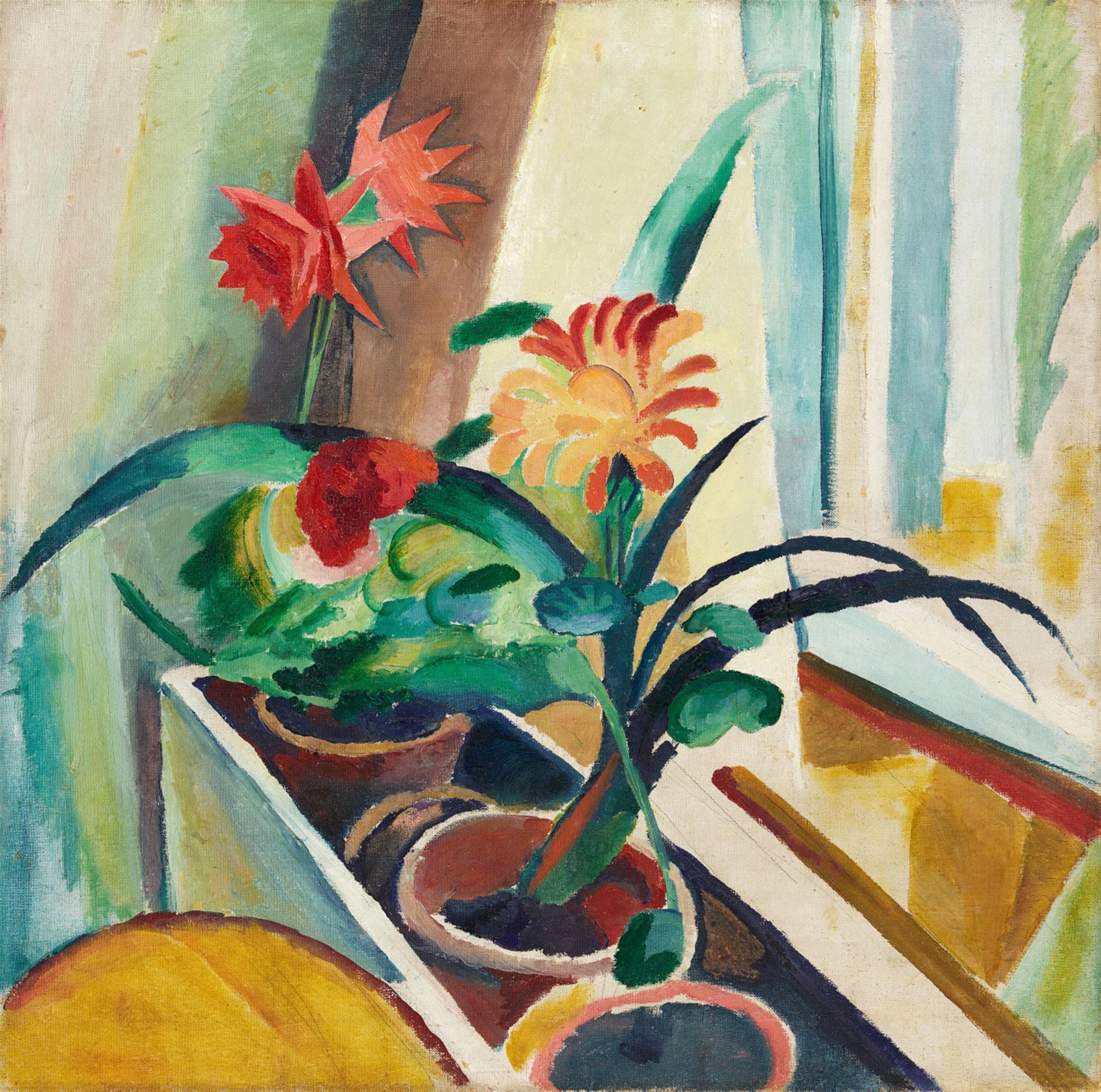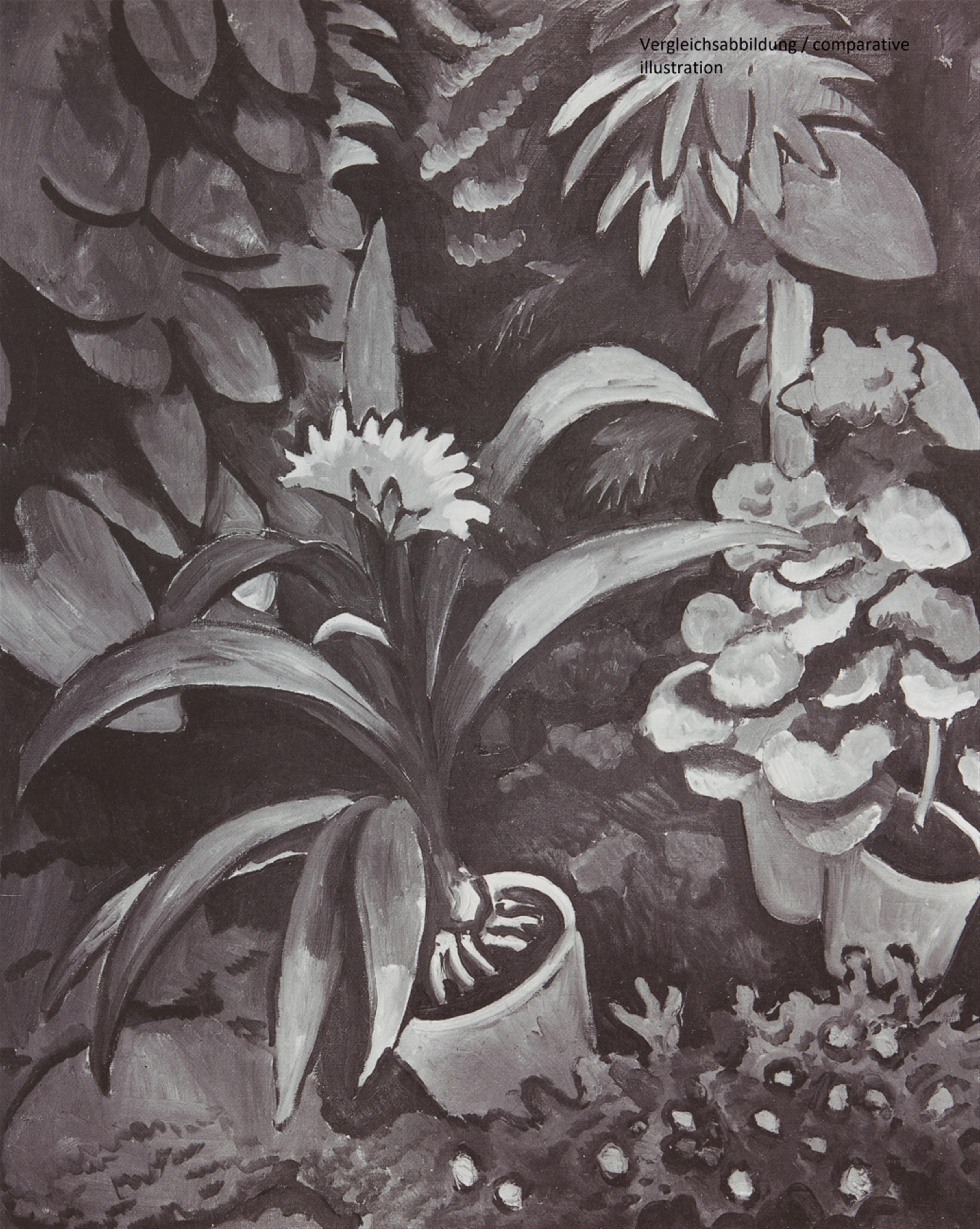August Macke
Blumenkasten mit Kaktus
1912
Oil on canvas 71.5 x 70.5 cm Framed. Verso inscribed "Blumenkasten mit Kaktus 1912" in black chalk on stretcher and on the canvas "18 [in circle] A. Macke Stilleben (Kaktus)" in black brush and dated "1912" in black chalk. - Singular minor retouches and fine inconspicuous craqueulre.
As terse as this motif featuring blooming plants in a flower box appears, August Macke has selected an almost life-size format for his image and thus invested it with a correspondingly imposing significance. The diagonal orientation of the flower box dynamically opens up the pictorial space. The dramatic effect of the assorted leaves extending out into the space around them and the luxuriant splendour of the flowers is laid out as if on stage. The red-orange of the blooms and the green of the leaves stand in complementary contrast to one another, evoking a movement that contributes to the rhythmic quality of the picture's entire motif through the strips of shadow and the folds of the curtains and making the objects seem to resonate in a gentle tone. When compared with the painting “Blumen im Garten: Clivia und Pelargonien” - which was created the previous year, 1911, and is now to be found in Munich's Lenbachhaus - the development from a more naturalistic to a semi-abstract depiction of nature becomes evident (see comparative ill.). The garden picture presents the pots - which seem to have been laid down at random and probably contain the same plants, that is, natal lilies and geraniums - within the “all-over” of the extremely dense vegetation. By contrast, the pictorial space in our work, where the flowers have also been joined by a flowering cactus, is structured and dynamised according to new artistic principles.
The year 1912 was an important one for August Macke: the painter was actively involved in the artists' group “Der Blaue Reiter” - by now, he had already become close friends with Franz Marc - and he was on the jury of the Sonderbund exhibition in Cologne. There he found current developments in the art of his time gathered together: tendencies he was able to utilise for his own painting, in addition to the inspirations experienced during his journeys to Paris. He was able to instil his wife Elisabeth's uncle Bernhard Koehler, who had an interest in art, with enthusiasm for also purchasing various works by Robert Delaunay. Macke also met Delaunay in person in Paris in 1912, and an artistic dialogue grew out of this encounter. In the autumn Macke went to an exhibition of Futurist paintings in Cologne and, that winter, he began processing his experiences of the previous months.
In the spring of 1913 he wrote to Koehler: “Nature has to emerge anew within us, we experience it anew from child[hood] on. The artwork is our experience, our marvelling at the measure of things, the rhythm in the artwork is a metaphor for the rhythm in nature itself.” (August Macke to Bernhard Koehler, 30 March 1913, cited in: exhib. cat., August Macke, Münster/Bonn/München 1987, p. 168).
Catalogue Raisonné
Heiderich 379
Provenance
Collection Günther Wagner, Pelikan-Werke, Hanover (1936); Private collection, Lower Saxony; Kunsthaus Lempertz, Auktion Moderne Kunst 26 May 1993, Lot 306; Private collection, Hesse
Literature
Lothar Erdmann, August Macke, in: Kunst der Nation, 1. Nummer Oktober 1934, II. yr., no. 19, with illus.; Gustav Vriesen, August Macke, Stuttgart 1953, cat. no. 333; Gustav Vriesen, August Macke, Stuttgart 1957, cat. no. 333, p. 326 with illus., p. 343 f.; Kunstpreisjahrbuch1993, vol. I, Munich 1993, p. 777 with illus.
Exhibitions
Dresden 1913 (Galerie Ernst Arnold), no cat.; Berlin/Hamburg/Stuttgart/Jena 1914 (Galerie Der Sturm/Kunstsäle Bock&Sohn/Kunstverein Stuttgart/Kunstverein Jena), no cat.; Krefeld 1921; Berlin 1934 (Galerie von der Heyde), cat. no. 21 (with stretcher label, no. "19"); Hamburg 1935 (Kunstverein); Hanover 1935 (Kestner-Gesellschaft), August Macke, cat. no. 26; Basel 1936 (Kunsthalle), Paula Modersohn-Becker, August Macke, cat. no. 84, there titled "Blumen am Fenster" (with stretcher label, "No. 1092")




